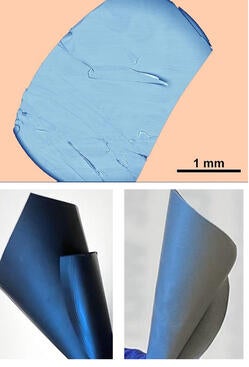
A team of UCR electrical engineers and material scientists demonstrated a research breakthrough that may result in wide-ranging advancements in electrical, optical, and computer technologies.
The Marlan and Rosemary Bourns College of Engineering research group, led by distinguished professor Alexander Balandin, has shown in the laboratory the unique and practical function of newly created materials, which they called quantum composites.
These composites consist of small crystals of called “charge density wave quantum materials” incorporated within a polymer (large molecules with repeating structures) matrix. Upon heating or light exposure, charge density wave material undergoes a phase transition that leads to an unusual electrical response of the composites.
Compared to other materials that reveal quantum phenomena, the quantum composites created by Balandin’s group exhibited functionality at a much wider range of temperatures and had a greatly increased ability to store electricity, giving them an excellent potential for utility.
The University of California, Riverside, researchers describe the unique properties in a paper titled “Quantum Composites with Charge-Density-Wave Fillers” published in the journal Advanced Materials. The lead authors of the paper are Zahra Baraniand Tekwam Geremew, UCR graduate students with the college’s Department of Electrical and Computer Engineering, who synthesized and tested the composites. Another UCR graduate student Maedeh Taheri is a co-author who helped with electrical measurements. Balandin and Fariborz Kargar, an assistant adjunct professor and project scientist, are the corresponding authors.
The term quantum refers to materials and devices where electrons behave more like waves than particles. The wave nature of electrons can give materials unusual properties that are used in a new generation of computer, electronic and optic technologies.
Materials that reveal quantum phenomena are sought for building quantum computers that go beyond the limitations of most computing that is now based on chips that use binary bits for computations. Such materials are also sought for super-sensitive sensors used for various electronic and optic applications.
But the materials with quantum phenomena have major drawbacks, Balandin said.
“The problem with these materials is that the quantum phenomena are fragile and typically observed only at extremely low temperatures,” he said. “The defects and impurities destroy the electron wave function.”
Remarkably, the charge density wave material in the quantum composites created by Balandin’s lab exhibited functionality as high as 50º C above room temperature. This transition temperature is close to the temperature of the operation of computers and other electronic gadgets, which heat up when they operate. This temperature tolerance opens a possibility for a wide range of applications of quantum composites in electronics and energy storage.
The researchers also found that quantum composites have an unusually high dielectric constant – a metric that characterizes the material’s ability to store electricity. The dielectric constant of the electrically insulating composites increased by more than two orders of magnitude, which allows for smaller and more powerful capacitors used for energy storage.
“Energy storage capacitors can be found in battery-powered applications,” Balandin said. “Capacitors can be used to deliver peak power and provide energy for computer memory during an unexpected shut-off. Capacitors can charge and discharge faster compared to batteries. In order to broaden the use of capacitors for energy storage, one needs to increase the energy per volume. Our quantum composite material may help to achieve this goal.”
Another possible application for quantum composites is reflective coating. The change in the dielectric constant induced by heating, light exposure, or application of an electrical field can be used to change the light reflection from the glasses and windows coated with such composites.
“We hope that our ability to preserve the quantum condensate phases in the charge-density-wave materials even inside disordered composites and even above room temperature can become a game changer for many applications. It is a conceptually different approach for tuning the properties of composites that we use in everyday life,” Balandin added.
The team at UCR collaborated with Megan Stokey, Matthew Hilfiker, and Mathias Schubert, of the University of Nebraska, who conducted some of the optical measurements, and Nicholas Sesing and Tina Salguero of the University of Georgia, who synthesized an ingredient material used in the composite preparation at UCR.
Cover image: Abstract concept of atom and quantum waves/Getty images





